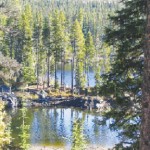If everyone who has a license to take water from the Okanagan Basin used it to the max, Okanagan Lake would disappear in pretty short order.
This is a dry valley, so there’s a huge demand for water and little supply.
In the commercial marketplace, that would mean it would fetch an enormous price, according to the law of supply and demand.
But, that’s not so compared to other jurisdictions, and it’s probably led to some of the water-wasting habits we have.
Apparently, Canada, B.C. and the Okanagan have some of the worst habits in the world in terms of wasteful water use.
It’s hard to convince people not to waste water when there’s ice and snow encasing every tree and shrub at lower elevations and perfect skiing conditions at upper elevations.
Dry is not what this valley appears to be right now.
And, snowpack measurements are at least normal this year, and in many areas of the valley, far higher than normal, which means we’ll likely have lots of snowmelt running off come spring.
That means water conservation could be a tough sell this spring as well. Nonetheless—particularly with expansive new housing developments being announced every day—it becomes more and more important that residents be more sensible about their use of water.
For the last year, the Okanagan Water Stewardship Council has been gathering information about water in the valley, and it’s been an interesting exercise.
Because the whole valley is represented on the council, it’s attracted the top players in various fields related to water and that’s been revealing on occasion.
Although you’d never know it by this El Nino year, often it brings persistent dry weather, but other than that, usually it’s pretty difficult to predict when drought conditions might occur.
Which means that drought management plans are an essential tool for utilities to have in place.
Rapid development in recent years has left utilities scrambling to plan for adequate storage so there’ll be water for all those new appetites.
Unfortunately, it comes down to the fact that just raising a dam—even if there aren’t a bunch of people already living where the new water would be stored—isn’t the ultimate answer to providing more water.
There’s a finite quantity of that precious resource.
In the Okanagan, it’s even more difficult to plan because very little is known about the supplies of water there are underground, and even less about the interaction between those supplies and what’s visible in streams and lakes.
There is an effort underway to find answers to the many questions about groundwater, but in the meantime, development continues apace.
I can’t help but wonder if that’s wise.
Judie Steeves writes about outdoors issues for the Capital News.

